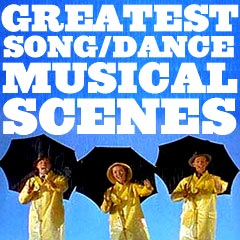
|
Musical Moments and Scenes M - 1 |
| M | ||
| Movie Title/Year and Scene Descriptions | ||

|
Man of La Mancha (1972) Filmed on location in Spain by director Arthur Hiller, this much-criticized film version of the long-running 1965 Broadway stage production (with Richard Kiley) starred Peter O'Toole (with singing voice of Simon Gilbert) as the title character Miguel de Cervantes in prison during the Spanish Inquisition - aka knight errant Don Quixote, with his faithful manservant Sancho Panza (James Coco). The film was also noted for Sophia Loren's portrayal of abused, busty, jailed scullery maid-prostitute Aldonza (the honorable Dulcinea envisioned in Quixote's delusional and mad mind). It was well- known for its memorable songs:
|
     
|
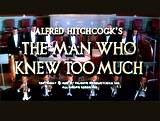
|
The Man Who Knew Too Much (1956)
Director Alfred Hitchcock's widescreened (VistaVision) and Technicolored suspense thriller was a 2-hour long remake of his own 1934 film. It was a story of political intrigue involving an assassination plot (of foreign Prime Minister (Alexis Bobrinskoy)), to occur in London's Royal Albert Hall - in the film's exciting finale. In two segments in the film, Doris Day (as retired singer and tourist wife Josephine "Jo" Conway McKenna) performed the Academy Award-winning Best Original Song Que Sera, Sera (Whatever Will Be, Will Be) (the film's sole Oscar win). Once, she sang the song to her young son Henry "Hank" McKenna (Christopher Olsen), and then accompanied herself on the piano in front of an audience at the foreign Embassy in London:
Other music in the film was composed by frequent Hitchcock collaborator Bernard Herrmann, including Arthur Benjamin's revised Storm Cloud Cantata (from the 1934 film) performed by the London Symphony Orchestra (and conducted by Herrmann himself in a cameo) in the film's conclusion. |
 
|
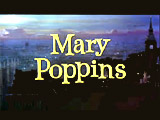
|
Mary Poppins (1964)
This popular Academy Award Special Effects-winning musical fantasy children's/family film from Walt Disney Studios, unique in that it had no stage origins, had an amazing blending of live action with animated cartoon characters and many imaginative numbers by magical nanny Mary Poppins (Oscar-winning Julie Andrews) in the P.L Travers-inspired 1934 tale, including:
The fantasy musical had 13 Academy Award nominations, with five winners (two were music-related):
|
     
|

|
M*A*S*H (1970)
Director Robert Altman's anti-war black comedy was about military doctors and nurses at a M*A*S*H (Mobile Army Surgical Hospital) during the Korean War. It inspired the long-running TV series. It was most famous for Private Seldman's (Ken Prymus) performance of Suicide Is Painless (pictured twice) for erectile-dysfunctioning and suicidal "Painless Pole" Walt Waldowski (John Schuck) in the "Last Supper" scene:
|
 
|
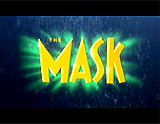
|
The Mask (1994) Most memorable was the entrance scene into the Coco Bongo Club of sexy blonde night-club singer Tina Carlyle (Cameron Diaz in her screen debut, singing voice of Susan Boyd) seductively singing Gee Baby Ain't I Good to You (pictured twice). Her appearance was breathtaking for The Mask/Stanley Ipkiss (Jim Carrey) in the audience - a yellow zoot-suited wolf with green skin. It caused him to drool over her (with his eyes popping, mouth/jaw dropping and tongue hanging out), and it also made his heart beat through his shirt (pictured). He was motivated to join her on stage (after exclaiming "Let's rock this joint"). He bent her over backwards, and engaged in a frenzied, exuberant, drum-accented dance with her in a number titled Hey, Pachuco (pictured) - (accompanied by the Royal Crown Revue band) - using physically impossible moves. Another particularly memorable dance number by the Mask was the Desi Arnaz song Cuban Pete (pictured) in front of a large group of police officers. |
     
|

|
This classic and very sentimental film was told in flashback and was based on the 1917 operetta with music by Sigmund Romberg. It was the third of MGM's popular and profitable Jeanette MacDonald/Nelson Eddy films - and considered the best of the series. It was a tale of unrequited love between two tragic lovers:
Together, they sang the film's theme song: Will You Remember? (pictured) in the May Day country fair sequence. She had just admitted to Paul that she was marrying her long-time tutor Nicolai Nazaroff (John Barrymore), although she was reluctant because it was a loveless pairing. The two were amidst flowering and blossoming apple trees as they pledged their eternal love in the beautiful duet:
In the magnificent, bittersweet and sentimental closing scene (pictured numerous times), the two unrequited lovers were reunited in death, when Marcia peacefully passed away in her home's garden, and her forever-youthful spiritual image rose from her body to meet and reunite with Paul's spirit singing to her within the garden gate with a reprise of their duet together: (Sweetheart, Sweetheart, Sweetheart) Will You Remember? The concluding images of the spirits of both Paul and Marcia were in eternity on a path showered with flower blossoms, as they strolled hand in hand down the country lane - toward heaven - after being united in death. |
   
|

|
(Monty Python's) The Meaning of Life (1983, UK) The many comic songs in this Monty Python classic included:
|
   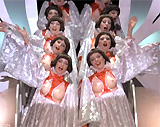 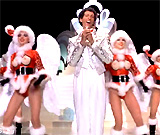 |
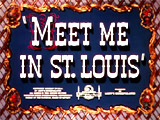
|
Vincente Minnelli's gorgeous musical (his third film and his first in color) romanticized and idealized the turn of the century at the time of the 1904 World's Fair. It was the second highest-grossing film for MGM up to that time. It included Judy Garland's (as winsome daughter Esther Smith) famous renditions of:
The title song Meet Me in St. Louis was sung by Garland, Joan Carroll, Harry Davenport, Henry H. Daniells, and Lucille Bremer. |
 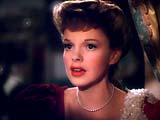 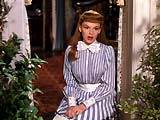 
|

|
The Merry Widow (1934) MGM's stylish, expressive and expensive film (spearheaded by producer Irving Thalberg) was red-headed soprano Jeanette MacDonald's first assignment with the studio, co-starring with her Paramount partner Maurice Chevalier under the direction of Ernst Lubitsch on loan from Paramount. It was the stars' fourth and final film together and their sole film with MGM - Chevalier left Hollywood the following year. New lyrics by Lorenz Hart and Gus Kahn supplemented the Franz Lehar score from the original 1905 operetta. It told the first 'talkie' version of the story (already filmed by Erich von Stroheim in the 1925 silent version) of wealthy widow Sonia (MacDonald) in the tiny kingdom of Marchovia in 1885, and her romance with the dashing, irresistible, handsome and roguish Count/Captain Danilo (Chevalier), who was sent to woo Sonia in Paris and keep her immense fortune within the kingdom, to avoid financial ruin for the small homeland. Included in the film were:
In one wonderful song-dance sequence, Chevalier and MacDonald danced cheek-to-cheek in the private dining room at Maxim's restaurant as she seduced him to the strains of the Merry Widow Waltz (pictured). Waltzing couples in a large ballroom were the highlight of the film's celebrated and grand production number at the Embassy ball - an extended Merry Widow Waltz sequence (with Academy Award-winning set design) (pictured), in which the duo danced the waltz together to a live orchestra with scores of others - who twirled down a long mirrored hallway. |
    
|
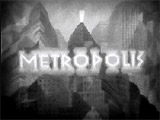 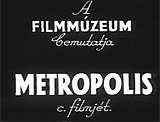
|
Fritz Lang's dystopic view of the future included evil (and false) robot Maria's (Brigitte Helm) seductively semi-nude erotic dance (censored upon the film's initial release) at the depraved Yoshiwara nightclub. The exotic dance drove the workers into a sexual frenzy (exhibited by a mosaic of disembodied eyes), before she called for them to violently revolt. |
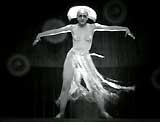  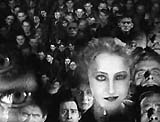
|

|
The theme song of this John Schlesinger-directed, X-rated (now R-rated) Best Picture and multiple-Oscar winning film was sung by Harry Nilsson (as Nilsson), the Grammy winnin Everybody's Talkin'. The song (not performed in the film itself) was heard in the background in the first part of the film (during the opening credits). Young, naive, uneducated, pretty-boy blonde Texan Joe Buck (John Voight) was introduced as a small-town, lowly dishwasher at Miller's Restaurant, but renting a room in the run-down Big Spring Motel. He showered, dressed, and preened himself in what he imagined to be the flashy, Hollywood-defined outfit of a stud - fringed leather, a stetson hat and shiny cowboy boots. He spoke directly into the camera - practicing his quitting speech to his employer: "You know what you can do with them dishes. And if you ain't man enough to do it for yourself, I'd be happy to oblige. I really would." Restless, he left while carrying an ugly cow-hide covered suitcase. He passed the front of the motel and proceeded by Rio movie theatre where the letters on the marquee for John Wayne's The Alamo were askew. The film's familiar, signature theme song played under the credits: Everybody's Talkin' (sung by Harry Nilsson) (pictured):
|
  
|

|
Million Dollar Mermaid (1952) This MGM film has been considered the best of Esther Williams' elaborate aquacade ballets - with two major sequences directed by Busby Berkeley, with some spectacular overhead shots of kaleidoscopic patterns of synchronized swimmers. Esther Williams portrayed 1920s Australian swimming champion Annette Kellerman ("The Australian Mermaid") in a recreation of her underwater aquatic tank performances at the NY Hippodrome Tank. In the first part of her spectacular show, four hundred water fountain streams shot up 30 feet to form a giant circular fountain, when Esther Williams arose from the center of the geyser on a small platform wearing a shiny gold full body suit - and then performed a graceful 40-foot swan dive into the water far below. In the next aquacade number, Esther was in the tank with a group of other swimmers (in a super-imposed image), surrounded by large flame plumes. Then, after a short interlude, her next show continued with a delicate underwater ballet (to the tune of Tchaikovsky's Nutcracker Suite (Dance of the Reed Flutes)). And in her final watershow at the Hippodrome, The Smoke Number, she appeared from behind a plume of red smoke, slid down a watery incline, and was dragged through the water with a large group of swimmers behind her, while backed by giant 4th of July-type fiery colored smoke streams that shot up fifty feet. These elements were combined with other trapeze performers who appeared on giant swings from behind smoke and dove into the water. She was pulled up while holding onto a ring, then dropped into the center of a circular group of swimmers far below. |
       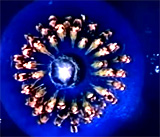 
|
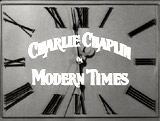
|
Actor-director Charlie Chaplin's own film was a final stand against the synchronized sound film - and his last full-length "silent film" - although it was technically a quasi-silent film. Chaplin's actual voice was heard singing an imaginary, nonsense song of gibberish (as a singing waiter). |

|

|
Monsters Inc. (2001)
This widely-anticipated animation, Disney's fourth computer-animated comedy with Pixar, featured a one-eyed, lime-colored ball named Mike Wazowski (with voice of Billy Crystal), and his scare-factory buddy James P. "Sulley" Sullivan (voice of John Goodman). Composer Randy Newman wrote the songs for the animation's musical score (it was his 4th feature film work for Pixar) and was the only one to win an Oscar from the film's four nominations:
[Note: Newman's nomination was his 16th nomination for either Song or Score since 1981 - and his first win!] |
 |
(alphabetical by film title) Introduction | A-1 | A-2 | B-1 | B-2 | B-3 | C-1 | C-2 | D-1 | D-2 | E | F-1 | F-2 | G-1 | G-2 H-1 | H-2 | I-J | K | L-1 | L-2 | M-1 | M-2 | N-O | P-1 | P-2 | R-1 | R-2 | S-1 | S-2 | S-3 | T | U-V | W | X-Z |